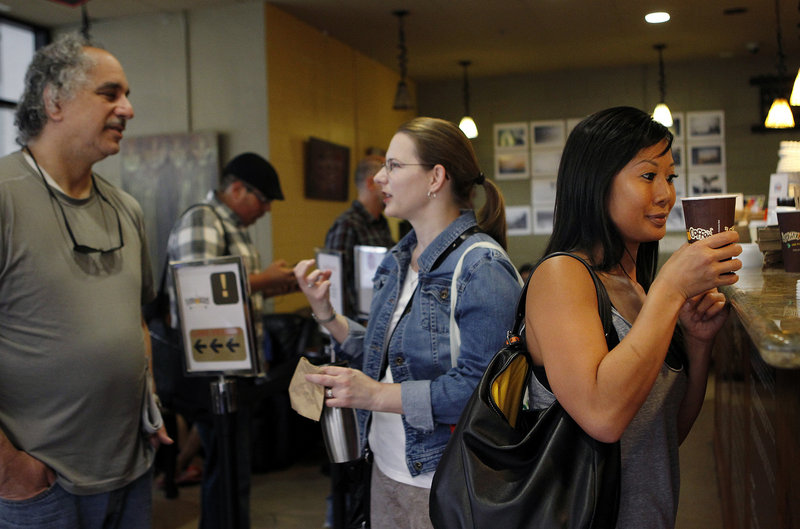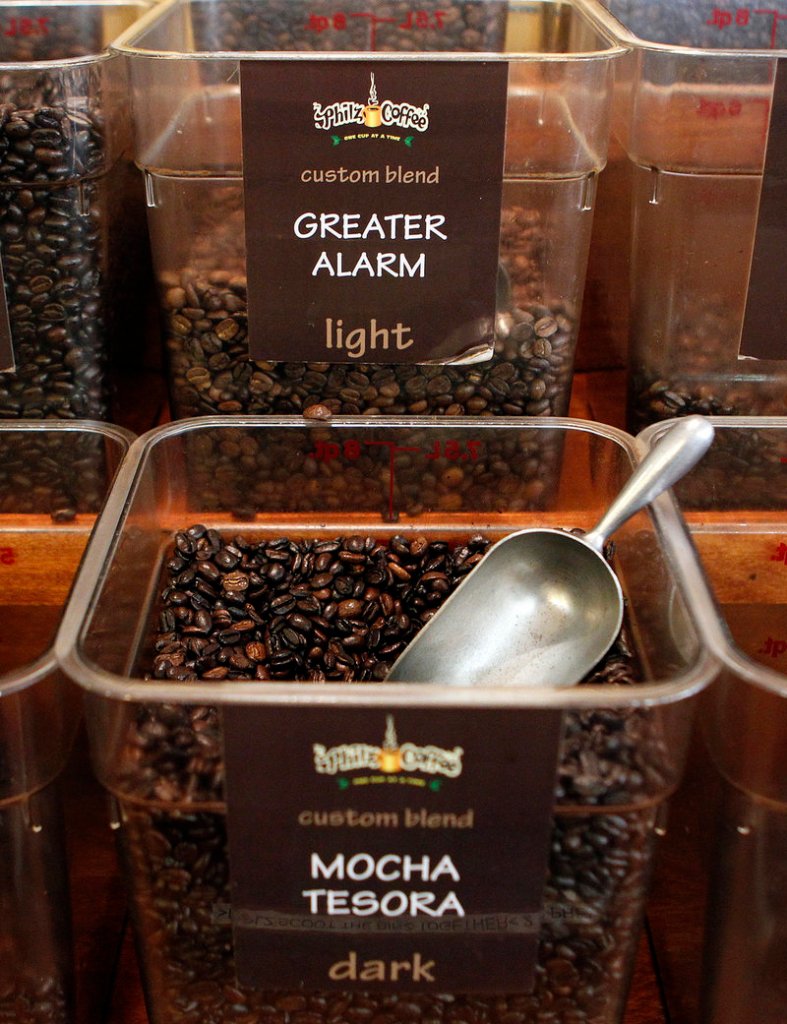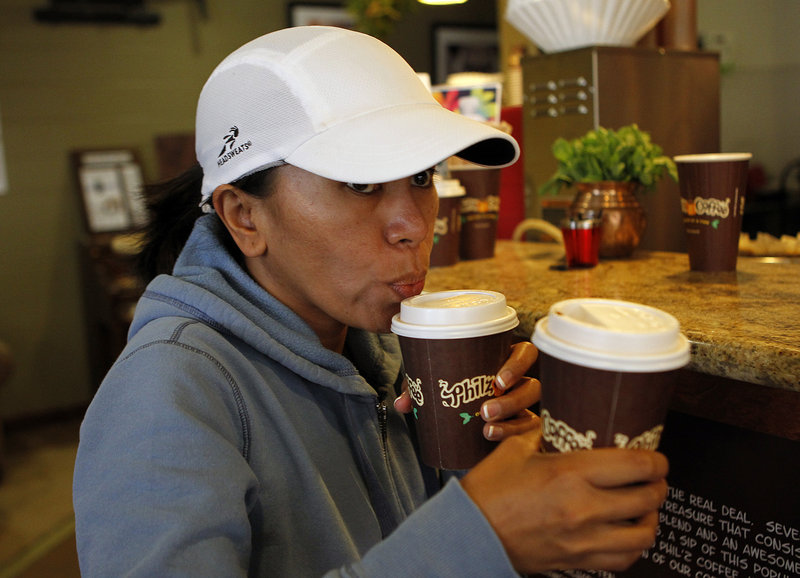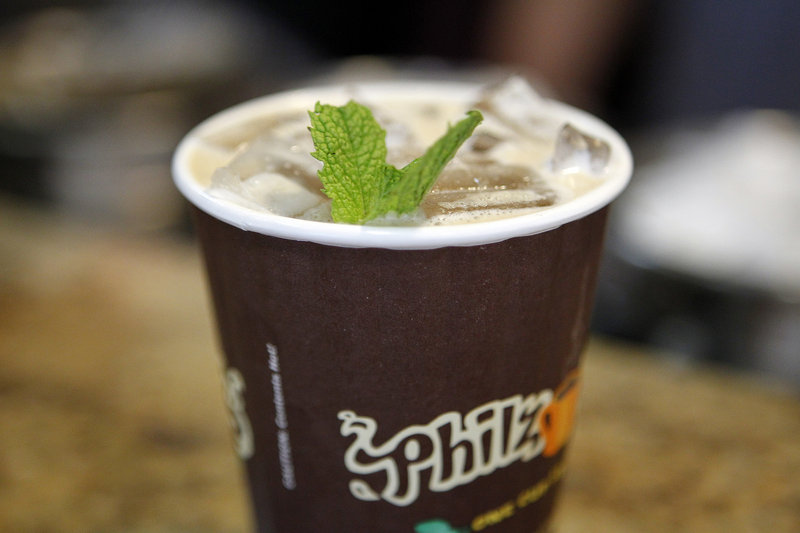SAN JOSE, Calif. – It’s the start of the morning rush at Philz Coffee — and things are slowing down.
Suits, students and hipsters all scurry into the cafe, only to then wait as baristas carefully prepare each cup of Tantalizing Turkish or Silken Splendor with the precision of bartenders mixing martinis.
Though the lines can be Starbucks long, Philz is decidedly the unStarbucks. Its coffee drinks start at $3 a cup and the service is meticulous. Baristas chat up the customers like old friends as they work their magic, blending different types of beans in grinders, dropping grinds into filters and then pouring water over them. They stir in rich warm cream — or 2 percent milk, if you choose. The preparation for each drink can take five minutes.
“The taste is worth the wait,” said Dale Anderson, a Cisco Systems employee who, along with some colleagues, luxuriated in the downtown cafe just a few steps from San Jose State University.
Philz is part of the so-called Third Wave in the coffee industry, following the canned coffee trend decades ago and the birth of Peet’s Coffee & Tea, Starbucks and other barista coffeehouses in the 1980s. While Third Wave prices might seem steep to some, those whose tongues have been tantalized by the perfected brews have no complaints.
Even money-strapped college students queue up for their daily fill of Philz, whose San Jose cafe feels like a comfortable college hangout. It has become such a part of the zeitgeist of the Twitter generation that it’s not uncommon to see customers posing for photos holding Philz coffee cups and then posting them online.
This alternative coffee shop is being watched warily by mainstream powerhouses Starbucks and Peet’s, which are experimenting with similar handcrafted drinks to not lose out on the trend sweeping Northern California and other select regions of the nation, said Alexander Slagle, an analyst with Jefferies & Co.
A Starbucks spokesman said a number of its cafes are now offering coffee brewed using the “pour-over method.”
“It’s an affordable luxury,” said San Francisco-based Slagle, admittedly a fan of slowly brewed coffees of the so-called slow-coffee cafes. “If you appreciate specialty coffee, high-quality beans and how they make single-pour, handcrafted drinks, then you’ll like it. It’s like drinking Russian River beer instead of Budweiser. There is an element of being hip. It’s a neat little segment.”
Actually, it’s quickly becoming not so little. The slow-coffee trend is catching on with the tech scene. Launched in 2003 with a single shop in San Francisco’s Mission district, Philz has 11 cafes that ring San Francisco Bay; a Cupertino, Calif., opening is in the works.
Philz also provides coffee to such companies as Google, Twitter and LinkedIn, has a cafe on the Facebook campus and is served on Virgin America flights. It is far from alone in this new coffee segment. Oakland, Calif.-based Blue Bottle Coffee and San Francisco-based Four Barrel, Sightglass and Ritual Coffee Roasters are serving up their slow-coffee concoctions to eager drinkers.
Peter Giuliano, an executive at the Specialty Coffee Association of America, believes the slow-coffee movement is a return to the drink’s pre-20th-century roots, when coffee was a luxury to be consumed with others. It was during early 20th-century America that the notion of coffee being a drink of the masses — an inexpensive way to make workers more productive — took hold, he said.
“Coffee has a long history of not being something that is cheap fuel for you on your way to work,” Giuliano said. “It has a history of being something that has conversation involved with it. When you slow down and appreciate coffee, it has a ritual aspect to it, not only around consumption but in its preparation.”
Rather than compete with traditional coffee shops, the new artisan coffees will enhance the overall industry, said Slagle, the analyst. Specialty coffee sold in cafes and grocery stores is a $17 billion industry in the United States that’s expanding at 8 to 10 percent a year, he said.
Blue Bottle Coffee, started in 2002 by professional clarinet player-turned-entrepreneur James Freeman, initially sold its coffee at an Oakland farmers market. After annual revenue increases of 30 to 40 percent, it took in between $15 million to $20 million in 2011, according to Freeman, who now has cafes in San Francisco, Oakland and New York City.
Freeman credits Starbucks and Peet’s with creating a coffee culture that is now open to his artisan coffee.
“One out of 1,000 people, or whatever the percentage is, wants something different, something a little more intricately constructed,” Freeman said. “It’s a palpably more interesting experience than a lot of faster options. Even in a challenging economy, people are lining up for our coffee. You can make people happy for less than $5.”
Ezequiel Cothran, an IT specialist at San Jose State who recently stopped by Philz for his morning fill-up of Mocha Tesora, said the key to slow coffee is the customer service.
“They make your mug to your specs,” he said. “It’s very smooth.”
Joann Truong, a marketing manager for a technology company in Fremont, Calif., has driven to downtown San Jose during her lunch break just to get a taste of Philz.
“I like Peet’s,” said Truong, sipping from her freshly brewed Philharmonic, made from a blend of different beans. “But once I got turned on to Philz, it was Philz all the way.”
Phil Jaber, 56, who began mixing beans in the 1970s to create the perfect cup of coffee for himself before launching Philz, speaks more like a mystical healer than a successful coffee entrepreneur.
“When you drink my coffee, it makes you calm, it makes you relaxed,” Jaber said. “When you taste it, you say, ‘Wow!’ It doesn’t get any better, my friend. It is medicine for your body.”
Send questions/comments to the editors.






Success. Please wait for the page to reload. If the page does not reload within 5 seconds, please refresh the page.
Enter your email and password to access comments.
Hi, to comment on stories you must . This profile is in addition to your subscription and website login.
Already have a commenting profile? .
Invalid username/password.
Please check your email to confirm and complete your registration.
Only subscribers are eligible to post comments. Please subscribe or login first for digital access. Here’s why.
Use the form below to reset your password. When you've submitted your account email, we will send an email with a reset code.